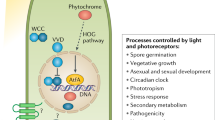Summary
Many fungi produce spores or spore-bearing structures under the control of blue light. Sporangiophores of Phycomyces blakesleeanus are produced continuously along racing tube cultures grown in constant darkness or constant light. However, if a dark-grown culture is exposed to light for a short time on one day a narrow, dense band of sporangiophores is observed the next day at that point of the tube occupied by the mycelial tips during the light pulse. A periodic program with “short days” (e.g., 4 h light; 20 h dark), leads to periodic bands of sporangiophores spaced at intervals corresponding to one period-length (in this case 24 h) of mycelial growth. Sporangiophore initiation is inhibited by a light to dark transition and is stimulated by a dark to light transition. A partial action spectrum of the initiation response, covering the critical 480–540 nm region, strongly suggests that the same photoreceptor pigment is involved as in the phototropic response and light growth response of sporangiophores. Mutants with altered light control of sporangiophore initiation have been found among those selected for altered phototropism. This joint elimination of these two responses to blue light by a single mutation is evidence for a common early transduction system.
Similar content being viewed by others
References
Aschoff, J. (ed.): Circadian clocks, Amsterdam: North-Holland 1965.
Bergman, K.: Sensory Responses of Phycomyces: I. Blue-light control of sporangiophore initiation. II. Classification of mad mutants. Doct. dissert., Calif. Inst. of Technol., Pasadena, CA, U.S.A. 1972.
Bergman, K., Burke, P.V., Cerdá-Olmedo, E., David, C.N., Delbrück, M., Foster, K. W., Goodell, E. W., Heisenberg, M., Meissner, G., Zalokar, M., Dennison, D. S., Shropshire, W., Jr.: Phycomyces. Bact. Rev. 33, 99–157 (1969).
Carlile, M. J.: The photoresponses of fungi. In: Photobiology of microorganisms (Halldal, P., ed.), p. 309–344. London-New York: Wiley-Interscience 1970.
Castle, E. S.: Differential growth and phototropic bending in Phycomyces. J. gen. Physiol. 48, 409–423 (1965).
Clayton, R. K.: Light and living matter: A guide to the study of photobiology, vol. 2: The biological part. New York: McGraw-Hill 1971.
Curry, G. M., Gruen, H. E.: Action spectra for the positive and negative phototropism of Phycomyces sporangiophores. Proc. nat. Acad. Sci. (Wash.) 45, 797–804 (1959).
Delbrück, M., Reichardt, W.: System analysis for the light growth reaction in Phycomyces. In: Cellular mechanisms in differentiation and growth (Rudnick, D., ed.), p. 3–44. Princeton: Univ. Press 1956.
Delbrück, M., Shropshire, W., Jr.: Action and transmission spectra of Phycomyces. Plant Physiol. 35, 194–204 (1960).
Faraj Salman, A. G.: Das Wirkungsspektrum der lichtabhängigen Zonierung der Koremien von zwei Mutanten von Penicillium claviforme Bainier. Planta (Berl.) 101, 117–121 (1971).
Galle, H. K.: Untersuchungen über die Entwicklung von Phycomyces blakesleeanus unter Anwendung des Mikrozeitrafferfilmes. Protoplasma (Wien) 59, 423–471 (1964).
Gressel, J. B., Hartmann, K. M.: Morphogenesis in Trichoderma: Action spectrum of photoinduced sporulation. Planta (Berl.) 79, 271–274 (1968).
Ingold, C. T.: Fungal spores: Their liberation and dispersal. London: Clarendon Press 1971.
Ingold, C. T., Marshall, B.: Further observations on light and spore discharge in certain pyrenomycetes. Ann. Bot. 27, 481–491 (1963).
Minis, D. H.: Parallel peculiarities in the entrainment of a circadian rhythm and photoperiodic induction in the pink bollworm. In: Circadian clocks (Aschoff, J., ed.), p. 333–343. Amsterdam: North-Holland 1965.
Page, R. M.: Studies on the development of asexual reproductive structures in Pilobolus. Mycologica 48, 206–224 (1956).
Pittendrigh, C. S.: On the mechanism of the entrainment of a circadian rhythm by light cycles. In: Circadian clocks (Aschoff, J., ed.), p. 277–297. Amsterdam: North-Holland 1965.
Ryan, F. J., Beadle, G. W., Tatum, E. L.: The tube method of measuring the growth rate of Neurospora. Amer. J. Bot. 30, 784–798 (1943).
Sargent, M. L., Briggs, W. R.: The effects of light on a circadian rhythm of conidation in Neurospora. Plant Physiol. 42, 1504–1510 (1967).
Sargent, M. L., Briggs, W. R., Woodward, D. O.: Circadian nature of a rhythm expressed by an invertaseless strain of Neurospora crassa. Plant Physiol. 41, 1343–1349 (1966)
Uebelmesser, E. R.: Über den endonomen Tagesrhythmus der Sporangienträgerbildung von Pilobolus. Arch. Mikrobiol. 21, 1–33 (1954).
Woodward, D. O.: Circadian rhythms in Neurospora. In: Behavior of Microorganisms. X International Congress for Microbiology. New York-London: Plenum Press 1972.
Author information
Authors and Affiliations
Rights and permissions
About this article
Cite this article
Bergman, K. Blue-light control of sporangiophore initiation in Phycomyces . Planta 107, 53–67 (1972). https://doi.org/10.1007/BF00398014
Received:
Issue Date:
DOI: https://doi.org/10.1007/BF00398014




